
For as long as we’ve pitted the MX-5 against a Type 86 (and it’s been a while now), the comparison has always been a bit lopsided. It’s tough against the roadster, obviously, as well as downright easy against a more focused sports car – or, as in more recent editions, the test pitted an abundantly available Mazda against a limited-motion Toyota which is sold in overpasses such as GT3. Clearly, anyone after a convertible faces only one choice here. But so stark are the other similarities – the low weight, rear-drive four-cylinder engines and standard six-speed manual gearbox – that bringing the two back together in the wake of a very modest MX-5 facelift proved irresistible.
Plus, it’s an inescapable fact that cars of this type are becoming rarer by the day. Even since pitting a GR86 against a BBR’d MX-5 less than two years ago, the Jaguar F-Type and Audi TT have finished production, another pair of cars you can count on to blow your mind in your hair and a smile. in your face. Things have gotten so bad that even Toyota, that great advocate of modern, driver-focused cars, has stopped taking orders for Supras in the UK. And they don’t seem to be coming back. We now live in a world without a Fiesta ST, where every Golf GTI is automatic, the BMW M2 lists a manual as an option, there isn’t a Hyundai N car with a combustion engine and an AMG A45 costs £65k. However, you can walk into a Mazda dealer tomorrow and place an order for a 1000kg, 7500rpm, six-speed sports car. Maybe even drive off with one. As long as that can happen, and as long as Toyota continues to say it has ‘limited GR86 availability’ on its website (or has cars with delivery mileage in the listings), we’ll continue to we direct them close to each other. Because (spoiler alert) they’re both great.
Despite the age of the underpinnings and despite the gray paint’s best efforts, it’s not hard to be immediately fooled by the little Mazda. The minor visual update (fixing the lights, really) has kept it looking modern and fresh – if still a bit heavy in RF form – and just seeing such a small and unassuming car on a 24 plate it is encouraging. The interior, although the architecture was introduced before the GT86 facelift, remains preferable to the GR in layout, functionality and material choice. The new infotainment setup looks smart in isolation and almost elegant when compared to Toyota’s etch-a-sketch display, the fonts are a model of clarity and the important controls just work. As with many MX-5 packages, it’s hard not to wonder why so many other manufacturers overcomplicate the basics.

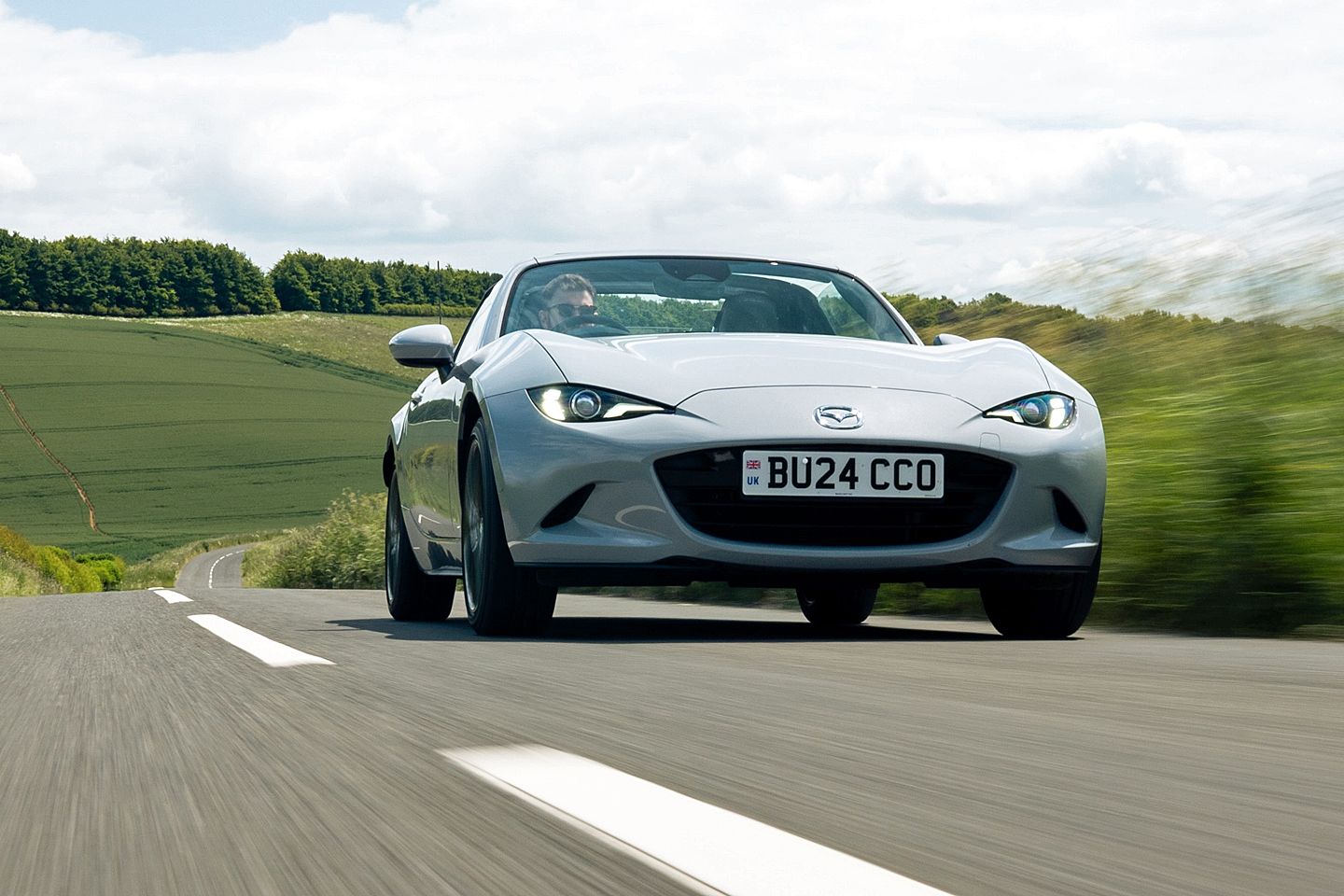
Of course, both Mazda and Toyota have the virtue of being small, light and deceptively simple. With each passing day, this combo becomes more desirable for anyone disenchanted (or worse) with overweight, over-engineered performance cars. Just look at them on the road here, with space in one lane and little noticeable chassis give. The necessary compromises made to achieve them are not drastic either; picture Oli squeezed into the back of the Toyota all right, and a large amount of shopping can go into the back of the Mazda. Modest doesn’t mean losing, and when barely a week goes by without being told how durable the vegan upholstery is on a 2.5-tonne plug-in V8, so the joy of driving two honest (ie unaided by a lithium-ion battery) 30mpg+, sub-200g/km sports car climbs exponentially. Heavier power means heavier brakes, tires, suspension and overall, heavier cars.
It takes about three minutes in an MX-5 to convince you that motor vehicles of almost any stripe can do if they’re around 500kg lighter and four-fifths the size. Perhaps after getting to know this 184bhp engine from 2018 (and Toyota’s 234bhp from ’22), you’ll want a little more power, but it’s likely that the joy of the manual gearbox, darting between hedges and sliding around turns will be quite distracting. . This latest ND update has brought the best out of the platform, too, making the MX-5 a little less mundane than it was before. The new limited-slip differential means it comes out of corners more assertively, the power goes exactly where it’s needed when it’s needed, and it works very nicely in conjunction with the Competition setting for DSC. Pushing the limits is no longer the leap of faith it once seemed, thanks to a more forgiving chassis and smarter assists. You’ll probably still want BBR springs, for the extra looks and precision, though they no longer feel essential.
Other than that, little has changed – it wasn’t necessary. Throttle response, pedal feel and gear shifting were impeccable, meaning they continue as some of the best on sale. Steering isn’t all that perfect, and having a wheel that feels a bit big doesn’t help with the sense of connection, although the composure of the whole package is confidence-inspiring. The cammy four-cylinder bark remains quite pleasant; the ride is basically well sorted for the job at hand. If modern cars are heavy and characteristically lightweight, the MX-5’s contemporary take on the classic sports car is still the perfect tonic.
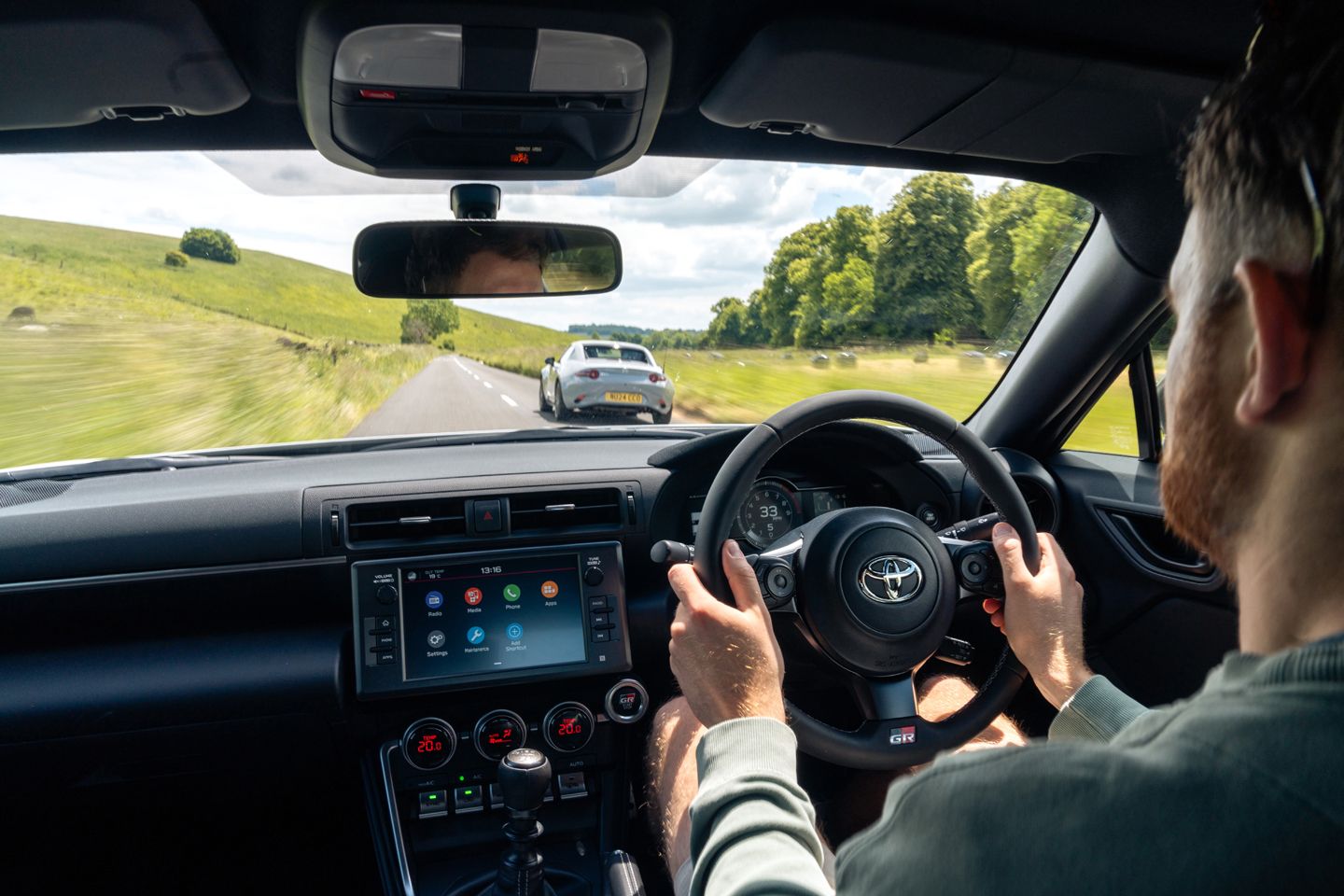
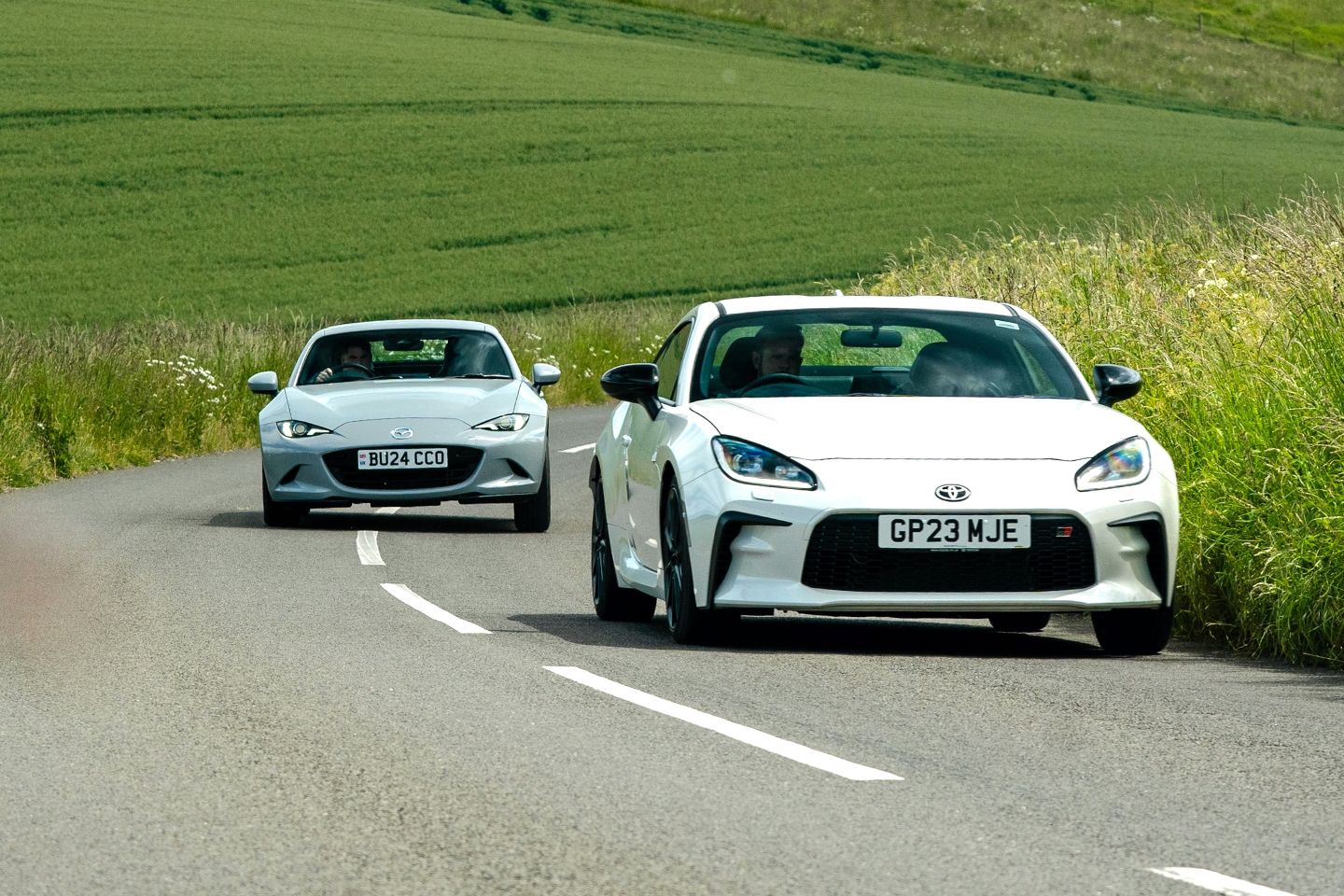
Toyota’s vibe is also unashamedly dated. But where the Mazda is the traditional British highway updated – a car for seaside trips and pub lunches if there ever was one – the 86 feels like the sports car it once was. This is the front-engine, rear-drive coupe for hillclimbing or sprinting, climbing the numbers, winning a trophy with it and being home in time for tea and crumpets. It’s a palpably more serious prospect than its rival, from the drop in gearshift to the speed of movement; The latter can actually make the 86 feel a little too harsh at low speeds, though you won’t be stuck in it for long. If we’re allowed to steal “built solid” from Ford, the Toyota feels built for years of enthusiastic driving in all sorts of scenarios – not being entirely at home around town is a price worth paying.
Even more than the MX-5, everything is at your disposal in the Gazoo Racing two-door to make the most of its driving. A wheel that isn’t set so well (it always feels a little low) responds more naturally, either by pushing it off-center or adding lock—this easy disconnect in the Mazda is accentuated by the 86’s immediacy and clarity. The brake pedal only offers a parts more weight and feel. The gearbox is not so glorious – it has to be satisfied only with the first rate. Track mode for assists offers greater freedom and subtler intervention than the Mazda, aided by a chassis that delivers infinitely more precision. Where the MX-5 might start to feel like it needs saving, the Toyota just needs a push in the right direction. Without a few very special Porsches, nothing quite harmonizes all the elements needed to enjoy driving like a GR86.
That was pretty much the case with the old 2.0-liter 86, and when driven like a top motoring video, the GT could feel fantastic. Where GR has moved the car so significantly – it’s been said before, but it bears repeating – is in making this sports car feel brilliant all the time. The engine has never been as good as the brakes, damping or gearbox – now it is. That means there’s joy to be had from the 2.4-litre unit whether it’s waiting for the gearshift signal or leaving it in a gear, carving a tidy line through a bend or pushing to the limit of grip, making progress or doing badly. A four-pot that was once a little out of sync with the rest of the package is now the perfect partner, another superlative element of an incredibly cohesive and immensely satisfying little sports car. It still doesn’t sound amazing, but you can’t have everything…
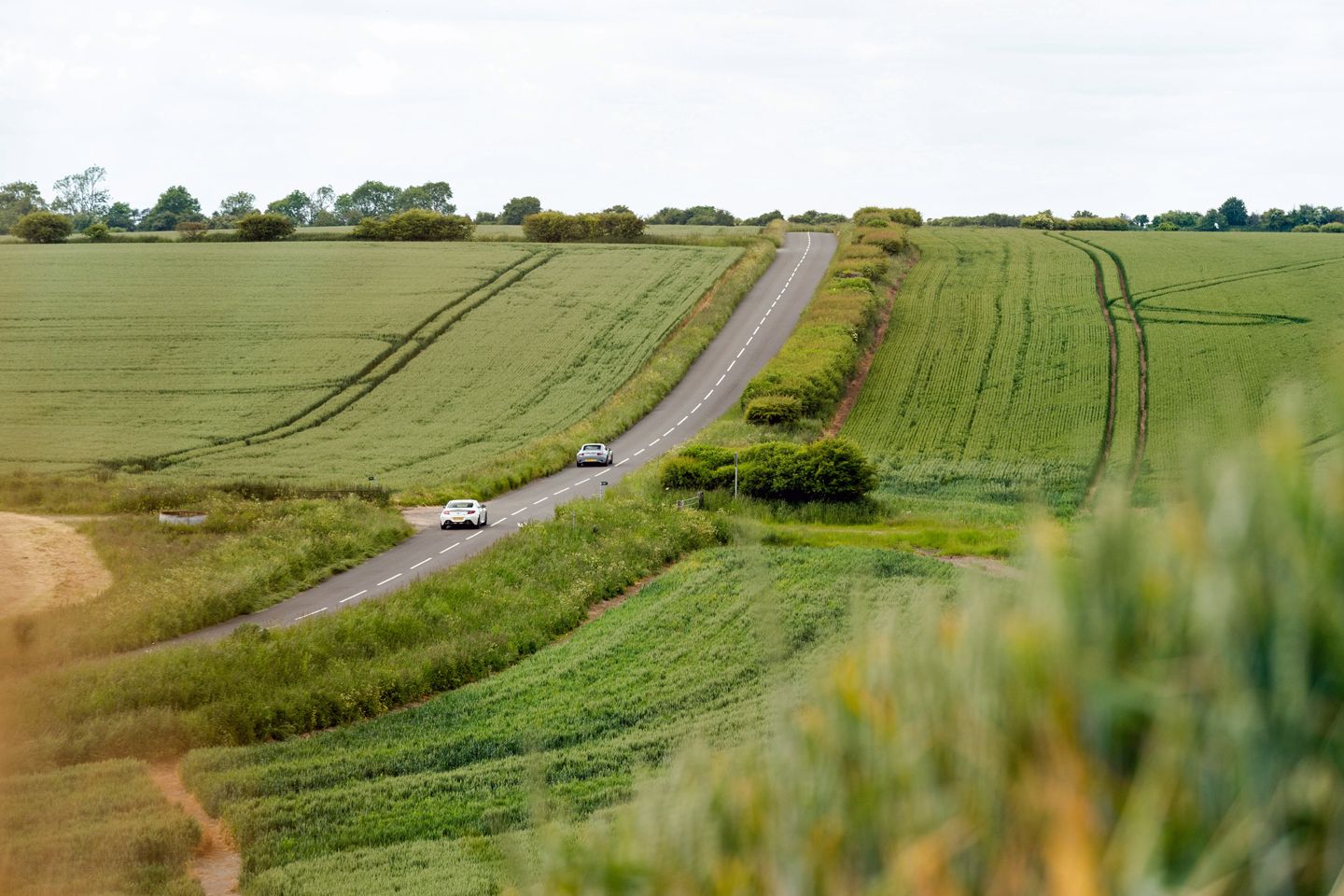
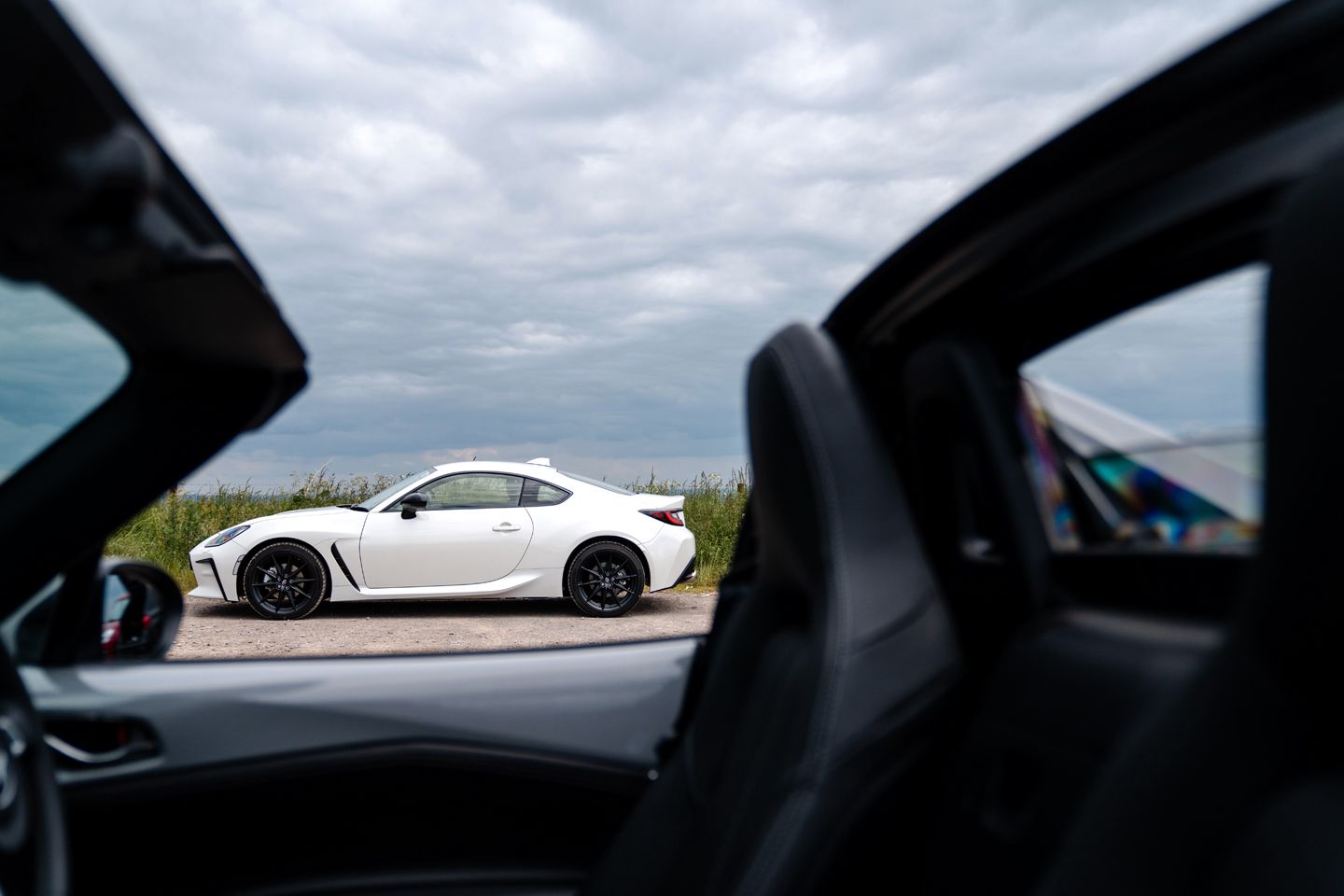
Both of these cars then engage and entertain like few others can – or even try to. There’s no mode angst over whether a section of the road could have been enjoyed more in Sport Plus, because both are designed to perform from the get-go; the only disappointment of the gearbox is when you don’t nail the shift; and instead of pulling over when a tractor is coming the other way, you can enjoy Japanese cars that feel made for British B-roads. That’s not to be a luddite about these things either; cars like the Hyundai Ioniq 5 N have ably demonstrated the possibilities that new technology has opened up. But it seems a shame that in many other cases the weight, complexity and asking price have increased, without a corresponding increase in fun. Never has relative simplicity and sweating the details produced two such fast(ish) nice cars. There should be something to learn from this going forward, even if six-speed manuals and naturally aspirated engines can’t last much longer. There is an authenticity to both cars that has yet to be replicated anywhere else.
Forced to choose one to drive off into the sunset, it will again be the keys to the Toyota you grab. Even the best ND MX-5 still can’t match the mix of performance, practicality and driver reward. As the Mazda begins to wither and sway, so the GR driver delights in its poise, precision and integrity. You feel at the core of everything you do well. Losing the pleasure of a folding roof is worth it for the driving excitement on offer. It will forever be a shame that the GR86 didn’t arrive sooner and in greater numbers; even the most dedicated GT fans have to admit that it has been weak in the last couple of years.
But having GR late is better than none, and it’s always worth repeating how good it is. As for the MX-5, the gap between its stats on paper (no more power, more money) and on-road experience (cool) feels wider than ever. Never has a car been less suitable for a by-the-numbers rating. It’s a reminder of how much fun driving can still be, and there aren’t many accolades greater than that. Let’s hope cars like these can find happy homes for many years to come – but even if they were to disappear tomorrow, they’d be wonderfully suited to an era that’s fast disappearing.
SPECIFICATION | 2023 TOYOTA GR86
Engine: 2,387cc, flat-four
Transmission: 6 speed manual, rear wheel drive
Power (hp): 234@7000rpm
Torque (lb ft): 184@3700rpm
0-62 mph: 6.3 seconds
Maximum speed: 140 mph
Weight: 1,275 kg-1,314 kg
MPG: 32.1
CO2: 198-200 g/km
Price: £32,495
SPECIFICATION | 2024 MAZDA MX-5 2.0 EXCLUSIVE RF LINE
Engine: 1998cc 4-cyl
Transmission: 6 speed manual, rear wheel drive
Power (hp): 184@7000rpm
Torque (lb ft): 151@4000rpm
0-62 mph: 6.5 sec
Maximum speed: 136 mph
Weight: 1,120 kg (including 75 kg driver)
MPG: 41.5mpg (WLTP combined)
CO2: 153 g/km
Price: £34,300 (price as standard; £34,870 as tested including Aero Gray paint for £570)